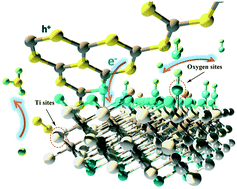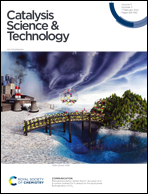Site-exposed Ti3C2 MXene anchored in N-defect g-C3N4 heterostructure nanosheets for efficient photocatalytic N2 fixation†
Abstract
Exploring highly active centers for N![[triple bond, length as m-dash]](https://www.rsc.org/images/entities/char_e002.gif) N triple-bond activation and the suppression of the competing H2 evolution reaction (HER) are key considerations for photocatalytic N2 fixation. As a novel 2D transition-metal carbide, Ti3C2 nanosheets (MXenes) have been recently considered as a promising N2 reduction reaction (NRR) active center. However, little of the expected progress in the use of Ti3C2 for photocatalytic N2 fixation has been achieved. Herein, we report a novel 2D/2D Ti3C2/N-defect g-C3N4 heterostructure photocatalyst exhibiting highly enhanced photocatalytic nitrogen fixation activity, with an NH3 yield of 5.792 mg h−1 g−1. This study demonstrates that the heterostructure was constructed by filling the oxygen-terminals of Ti3C2 in the N-defects of g-C3N4 to form C–O–Ti interactions. Together, the construction of the hetero-interface and the introduction of N-defects contribute to rapid interfacial charge transfer to the active sites. Importantly, the exposed edge Ti of Ti3C2 was confirmed to be the active site for N2 adsorption and activation, and these active Ti sites exhibit desirable NRR selectivity via suppressing the competing HER. Finally, a mechanism for photocatalytic N2 fixation was proposed to reveal the evolution of the redox circle that originated from the multi-valence Ti species during the N2 adsorption, activation, and dissociation process.
N triple-bond activation and the suppression of the competing H2 evolution reaction (HER) are key considerations for photocatalytic N2 fixation. As a novel 2D transition-metal carbide, Ti3C2 nanosheets (MXenes) have been recently considered as a promising N2 reduction reaction (NRR) active center. However, little of the expected progress in the use of Ti3C2 for photocatalytic N2 fixation has been achieved. Herein, we report a novel 2D/2D Ti3C2/N-defect g-C3N4 heterostructure photocatalyst exhibiting highly enhanced photocatalytic nitrogen fixation activity, with an NH3 yield of 5.792 mg h−1 g−1. This study demonstrates that the heterostructure was constructed by filling the oxygen-terminals of Ti3C2 in the N-defects of g-C3N4 to form C–O–Ti interactions. Together, the construction of the hetero-interface and the introduction of N-defects contribute to rapid interfacial charge transfer to the active sites. Importantly, the exposed edge Ti of Ti3C2 was confirmed to be the active site for N2 adsorption and activation, and these active Ti sites exhibit desirable NRR selectivity via suppressing the competing HER. Finally, a mechanism for photocatalytic N2 fixation was proposed to reveal the evolution of the redox circle that originated from the multi-valence Ti species during the N2 adsorption, activation, and dissociation process.



 Please wait while we load your content...
Please wait while we load your content...